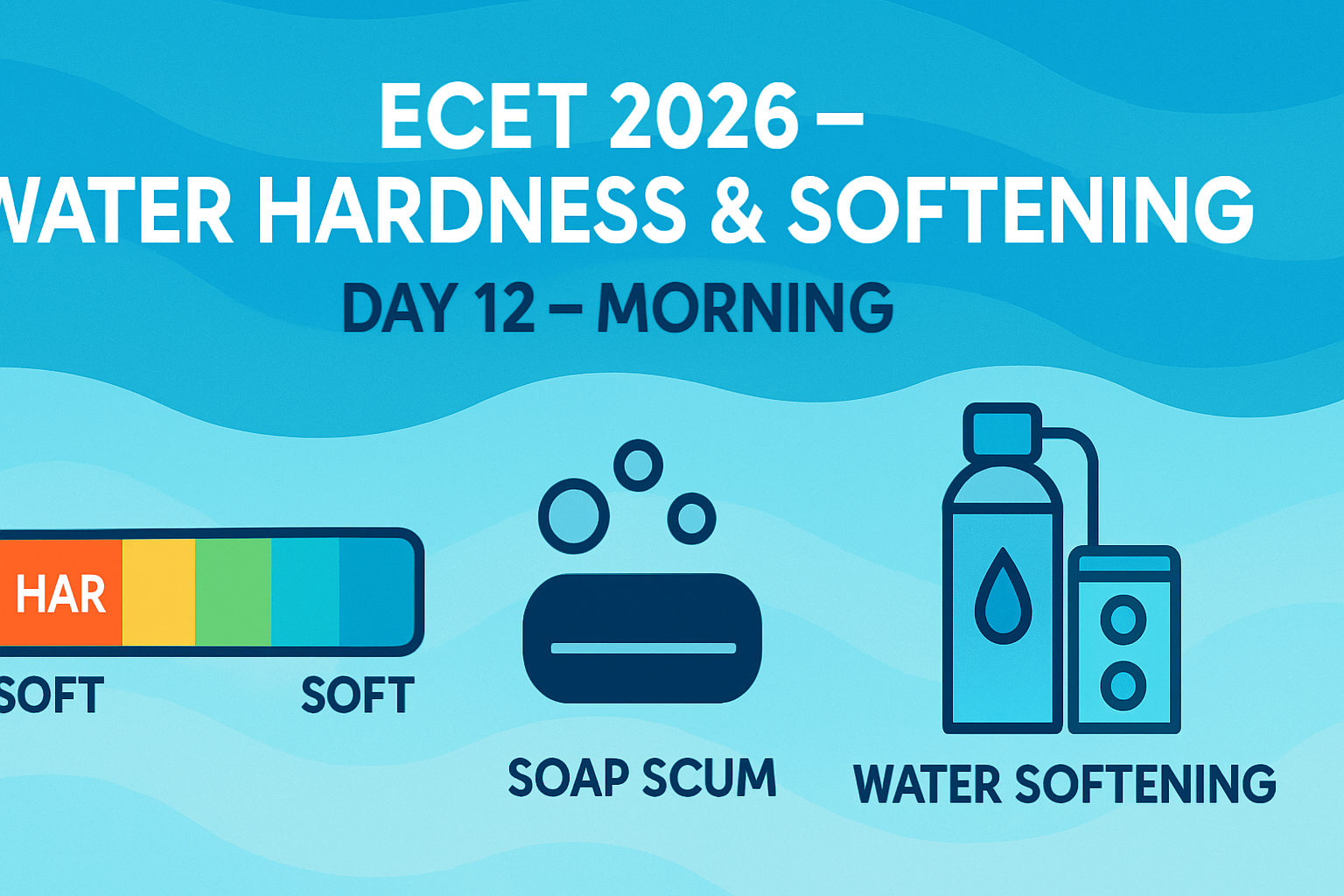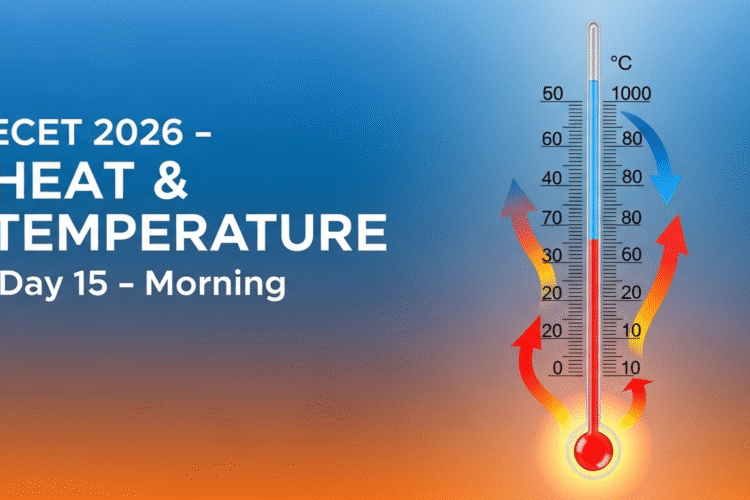
In the ECET 2026 General Science section, Water Hardness & Softening is a recurring Chemistry topic. Questions often test your ability to identify types of hardness, methods of removal, and related chemical reactions. Mastering this chapter ensures quick-scoring answers and builds applied chemistry knowledge that’s useful in daily life and engineering fields.
📘 Concept Notes – Water Hardness & Softening
💧 What is Water Hardness?
- Hardness of water is due to the presence of dissolved salts of calcium (Ca²⁺) and magnesium (Mg²⁺).
- Hard water does not lather easily with soap; instead, it forms scum.
📂 Types of Water Hardness
- Temporary Hardness:
- Caused by bicarbonates of calcium and magnesium.
- Example: Ca(HCO₃)₂, Mg(HCO₃)₂
- Removed by: Boiling or Clark’s method (lime addition).
- Permanent Hardness:
- Caused by chlorides and sulfates of calcium and magnesium.
- Example: CaCl₂, MgSO₄
- Removed by: Ion exchange method, Zeolite method.
🔢 Measurement of Hardness
- Unit: ppm (parts per million) or mg/L
- EDTA titration is commonly used in labs.
🧪 Water Softening Methods
- Boiling:
- Removes temporary hardness by decomposing bicarbonates into carbonates, which precipitate out.
- Reaction:
Ca(HCO₃)₂ → CaCO₃ ↓ + H₂O + CO₂ ↑
- Clark’s Method:
- Adding slaked lime [Ca(OH)₂] to remove temporary hardness.
- Zeolite (Permutit) Method:
- Sodium zeolite replaces Ca²⁺ and Mg²⁺ with Na⁺ ions.
- Ion Exchange Method:
- Uses resins to exchange hardness-causing ions with sodium/hydrogen ions.
💡 Key Points for ECET:
- Temporary hardness → Boiling / Lime treatment
- Permanent hardness → Zeolite / Ion exchange
- Both types → Distillation or Ion exchange
🔟 10 Most Expected MCQs – ECET 2026 [Water Hardness & Softening]
Q1. Hardness of water is mainly due to:
A) Na⁺ and K⁺ ions
B) Ca²⁺ and Mg²⁺ ions
C) Cl⁻ and SO₄²⁻ ions
D) Fe²⁺ and Fe³⁺ ions
Q2. Temporary hardness is caused by:
A) Chlorides of Ca and Mg
B) Sulfates of Ca and Mg
C) Bicarbonates of Ca and Mg
D) Carbonates of Na and K
Q3. Which method removes only temporary hardness?
A) Ion exchange
B) Zeolite method
C) Boiling
D) None
Q4. Clark’s method uses:
A) Quicklime
B) Slaked lime
C) Sodium carbonate
D) Zeolite
Q5. Permanent hardness can be removed by:
A) Boiling
B) Lime water
C) Zeolite method
D) Filtration
Q6. Which unit is used to express water hardness?
A) ppm
B) atm
C) m/s
D) °C
Q7. Zeolite method replaces Ca²⁺ and Mg²⁺ with:
A) K⁺ ions
B) Na⁺ ions
C) Cl⁻ ions
D) SO₄²⁻ ions
Q8. Ion exchange resins are used for:
A) Increasing pH
B) Softening water
C) Adding hardness
D) Boiling water
Q9. What forms when soap reacts with hard water?
A) Lather
B) Salt
C) Scum
D) Foam
Q10. Distillation can remove:
A) Temporary hardness
B) Permanent hardness
C) Both
D) None
✅ Answer Key Table
| Q.No | Answer |
|---|---|
| Q1 | B |
| Q2 | C |
| Q3 | C |
| Q4 | B |
| Q5 | C |
| Q6 | A |
| Q7 | B |
| Q8 | B |
| Q9 | C |
| Q10 | C |
🧠 Explanations of All Answers
- Q1 → B: Ca²⁺ & Mg²⁺ ions cause hardness.
- Q2 → C: Temporary hardness comes from bicarbonates of Ca and Mg.
- Q3 → C: Boiling decomposes bicarbonates → removes temporary hardness.
- Q4 → B: Clark’s method uses slaked lime [Ca(OH)₂].
- Q5 → C: Zeolite method removes permanent hardness.
- Q6 → A: Hardness is expressed in ppm (parts per million).
- Q7 → B: Sodium zeolite exchanges Na⁺ for Ca²⁺ and Mg²⁺.
- Q8 → B: Ion exchange resins soften water.
- Q9 → C: Scum is formed when soap reacts with hard water.
- Q10 → C: Distillation removes both temporary & permanent hardness.
🎯 Why This Practice Matters for ECET 2026
This is a repeated and easy Chemistry topic in ECET exams. With direct and formula-based questions, you can secure 1–2 quick marks. The key is remembering types, causes, and removal methods. Practicing MCQs ensures accuracy and speed in the exam.
📲 Join Our ECET Prep Community on Telegram
Get daily MCQs, notes, and practice papers straight to your phone.
👉 @LearnNewThingsHub
![]()



